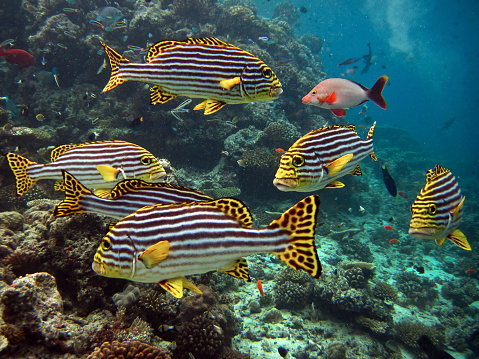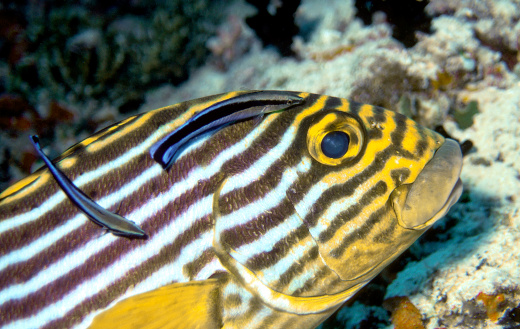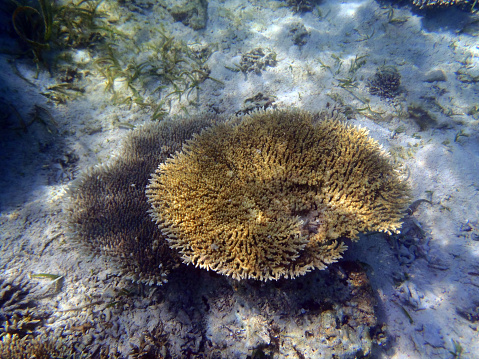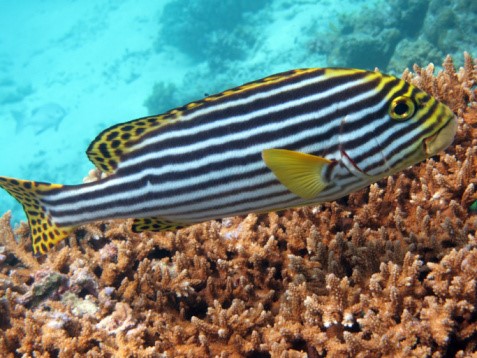A hidden gem in the Maldives: The Oriental sweetlips fish
The Oriental sweetlips fish in the Maldives is a hidden gem for any visitor to the stunning archipelago. With its vibrant colours and unique behaviour, the Oriental sweetlips fish is an eye-catching creature that is sure to make any visit to the Maldives memorable. This post will discuss the unique characteristics of the Oriental sweetlips fish and why it is such a must-see in the Maldives.
What makes the Oriental sweetlips fish so special?
The Oriental sweetlips fish of the Maldives, also known as the Clown sweetlips, is an incredibly special fish that can only be found in the warm waterways of the Maldivian islands. Natives to this region have long admired this striking creature for its vibrant mix of colours, which range from bright yellow to dark brown, and its amusing behaviour. Moreover, it has unique characteristics that make it a deadly, yet entertaining, predator in its environment.

The first thing that sets the Oriental sweetlips fish of the Maldives aside is its unique set of adaptations that allow it to thrive in the shallow, warm waters of the region. The fish has an especially wide mouth, enabling it to feast on a wide range of small prey, such as small fish, crabs, and shrimps.
It also has a sleek, maneuverable body shape which allows it to swim gracefully around the sandy and rocky seabeds, as well as a light-coloured mask, which helps to camouflage itself from potential predators. Furthermore, the fish’s bright yellow-coloured pectoral, anal, and caudal fins, which are enlarged and have a ragged edge, can be used for communication between the fish, enabling them to gather in large schools.
Where can you find them?
The Oriental Sweetlips fish (Plectorhinchus Orientalis) is found throughout the tropical waters of the Indian Ocean, particularly in and around the Maldives. They are usually seen in groups of two or three, but sometimes even larger shoals of up to twenty individuals. These fish may also swim near the shore in shallow waters and are a popular sight among scuba divers and snorkelers.
The sweetlips fish is easily recognized by its distinctive silver body with vertical yellow stripes and large lips, which give it its name. Its body is covered by scales, with a large, black eyespot near its gills. The average fish is about twenty centimetres in size, though they may grow to more than fifty centimetres in length.

The most common place to find sweetlips fish in the Maldives is within the reefs. These underwater habitats provide the fish with plenty of food, shelter, and structures to hide in, as well as providing some protection from predators. However, sweetlips fish can also be found in open waters, often near coral gardens.
What do they eat?
When providing mealtime nutrition for Oriental sweetlips, it is best to mimic their natural diet. Generally, this includes a combination of meaty, fatty, and plant-based foods. It is most beneficial to use a variety of small feeder shrimp, fish, worms, and other invertebrates, as well as flake and pellet fish food that is specifically designed with their nutritional requirements in mind. For vegetable matter, you can offer frozen daphnia and mosquito larvae, as well as fresh, frozen, or freeze-dried vegetable-based food or flakes, frozen or fresh seaweed, and other types of leafy green matter.
How can you help preserve them?
The first way to help preserve Oriental sweetlips fish is to spread awareness about the importance of preserving this species. Educating the public on the threats the species faces and why it is important to protect it can help to drive home the need for conservation and can motivate people to take action. Potentially, individuals can join or create a campaign to bring attention to the species and its plight.
The second way to help preserve Oriental sweetlips fish is to buy sustainably-sourced fish. When purchasing fish, it is important to make sure that it has been farmed and fished responsibly and not through damaging practices such as trawling. Many organizations are dedicated to ensuring sustainable practices, such as the Marine Stewardship Council, and looking for goods with their label is a good way to help preserve the species.
Oriental sweetlips’ behaviour & ecology
The open coastal environment and coral reefs of the Indo-Pacific provide a conducive habitat for Oriental sweetlips. The fish are typically found in groups of up to twenty individuals, sheltering among thick reef crevices or behind large coral formations. During the day they remain hidden in their lairs, only emerging at night to feed. This feeding behaviour can involve lone individuals moving slowly around the reef while using their heightened sense of hearing to detect prey.
Oriental sweetlips’ reproduction
Oriental Sweetlips undergo a process of internal fertilization. To provide the Top of sperm and eggs to be released into the water column, they replicate the sexual process found in other fish species. During this annual spawning event (which typically occurs in late summer/early fall), males and females gather in large schools near coral reefs or near ocean-floor boulders. Here, the male courts the female by swimming in circles around her, to give her his scent and to maintain a secure position for the spawning process.
Oriental sweetlips habitat
Oriental Sweetlips live in shallow reefs and lagoons. During the day, the fish are often seen swimming in the open water, among schools of smaller, brightly coloured reef fish. As the sun sets, however, the Oriental Sweetlips will retreat to the reef crevices, where they spend the night hiding. This behaviour is thought to give them both protection from larger predators as well as refuge from the harsh sunlight.

Oriental sweetlips threats
Oriental Sweetlips populations have undergone rapid decline due to human activities. The main threats to this species include overfishing, destruction of reefs, incidental catches, and pollution. In areas with high-intensity fishing or pollution, these species have a hard time recovering from destruction. The destruction of reefs has been linked to the destruction of the fish habitats, resulting in fewer fish for the population.

